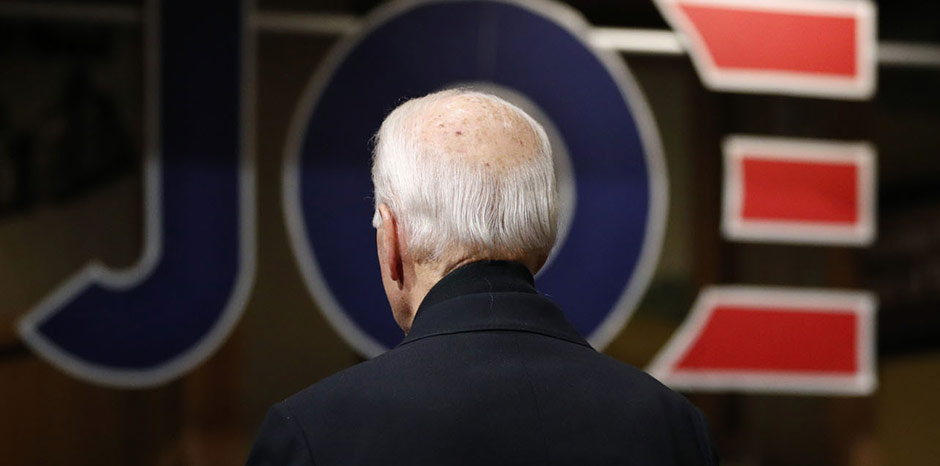FY 2021 Outlook & Comment
Back to the future

Can Joe Biden take the USA back to the future? If recent market developments are to be believed, the answer is yes. PATRICK SEMANSKY AP KEYSTONE
While the first coronavirus vaccines are being delivered and Joe Biden is getting ready to move into the White House, the future has already begun on the financial markets. It remains to be seen whether it will develop as positively as investors’ current optimism suggests. As a result, the consensus regarding low inflation could prove to be nothing more than an illusion.
Light at the end of the tunnel
Compared to past recessions, the recovery from the pandemic-driven economic downturn in the spring has been extremely rapid. This was primarily down to the unprecedented extent to which fiscal support programmes compensated for income losses. Nevertheless, economic performance is still exhibiting gaps of a similar magnitude to those seen at the lowest point of the global financial crisis.
A second wave of infection, which is now hitting the United States after sweeping across Europe, threatens a relapse into recession. However, rapid progress in vaccine development is sparking hope of an accelerated economic recovery from the second quarter of next year.
Despite reflationary expectations, continued intervention by central banks in the OECD area should ensure that interest rates remain low at the short end and rise at best moderately at the long end of the curve. Hopes of extensive additional fiscal programmes were dampened in particular by outcome of the elections in the United States.
Shaped by the experience of the global financial crisis, the prevailing consensus expectation that low inflation will persist could prove deceptive. In contrast to the situation back then, when above all European governments imposed a pro-cyclical austerity policy on themselves, today the states are channelling the created central bank liquidity into private households in the form of fiscal aid programmes.
The US Federal Reserve’s historically unique step of creating an explicit backstop for the credit market has established corporate bonds as a higher-yielding substitute for Treasuries. However, the resulting detachment of the credit market from any fundamental mooring demands selectivity from investors.
The ongoing financing requirements for the dual deficits of the US budget and current account, which have swollen to immense proportions, will maintain the pressure on the US currency in the coming year.
Your contact

Dr. David-Michael Lincke
Head of Asset & Portfolio Management
+
Equities: recovery fully priced-in
Despite substantial gaps in economic performance, which are of a similar magnitude to those seen at the lowest point of the global financial crisis, the equity markets have experienced a V-shaped recovery. This was led by the US equity market, where the technology sector – which is benefiting from the restrictions imposed to contain the pandemic and is therefore considered defensive – has become the main driving force.
A sustained positive mood is entrenched by three factors: (1) hope of additional major fiscal stimulus programmes, (2) unbroken confidence in the ability of central banks to keep interest rates low, leaving investment in equities without alternative and (3) hope of an accelerated breakthrough on the medical front with effective vaccines and therapeutics.
The strong price gains in the broad benchmarks disguise the fact that the recovery has been driven by only a few sectors. The phenomenon of the sustained weakness of cyclical value stocks (value factor) compared to growth stocks (growth factor) has further accentuated and accelerated. However, a sustained trend reversal in favour of cyclically sensitive securities is beginning to emerge with the imminent broad availability of effective vaccines.
The outlook for Asia and the emerging markets is brightening. China is the first major economy to return to its GDP growth path before the outbreak, while Asia as a whole is benefiting from rigorous containment of the pandemic.
Extreme overvaluation and the high dependency on technology equities have caused us to take a step back from the American equity market. The prospect of successfully overcoming the pandemic in the near future makes a portfolio shift towards cyclical securities and sectors seem advisable. In addition to commodities and cyclical consumer goods, financial securities are also piquing our interest.
Overall, the global equity market offers a somewhat unattractive outlook for the coming year. This is atypical for the current phase of the economic cycle, when the economy is just beginning to recover from a deep and sharp recession. But the possible recovery and a good part of the subsequent expansion phase has already been anticipated. For investors, this means that a passive investment approach based on the major benchmarks is likely to produce disappointing results over the coming years. Instead, selectivity is advised and preference should be given to active investment approaches.
Your contact

Dr. David-Michael Lincke
Head of Asset & Portfolio Management
+
Commodities: every indicator is pointing to a bull market
The commodity markets were also hit hard by the outbreak of the Covid pandemic. However, apart from the energy sector, which was hit hard by the global decline in mobility, the majority of other sectors have already fully recovered.
One major contributor to this development has been the rapid recovery in China, which was the first major economy to return to its pre-virus GDP growth path and has stimulated demand for base metals with fiscal measures focused on infrastructure investment. Precious metals initially benefited from their traditional role as a safe haven and also subsequently from the sustained decline in real interest rates and the weakening of the US dollar, while unfavourable weather conditions, high demand and logistical bottlenecks from the summer onwards boosted agricultural prices.
In our opinion, the outlook for this year will be determined by developments on three fronts: (1) years of insufficient investment activity with regard to maintaining and expanding production capacities in resource extraction, (2) increasing demand due to policy-driven stimulus and investment programmes and (3) macroeconomic tailwind in the form of rising inflation risks and continued weakening of the US dollar.
The fate of the fossil energy sector remains closely linked to a normalisation of global economic activity and in particular mobility. The extent and speed at which international air traffic returns to normal will be decisive. The demand basis for base metals is likely to broaden as major green technology infrastructure programmes in Europe and beyond continue, while persistently low real interest rates and a weak US currency will sustain investor interest in precious metals. In the agricultural sector, a response to supply is to be expected In view of high prices. However, the danger of a particularly severe La Niña weather phenomenon could counteract this.
Your contact

Dr. David-Michael Lincke
Head of Asset & Portfolio Management
+
India: on the road to recovery?
The India economy was impacted by a strict nationwide lock down for two months. After witnessing deepest correction in the third quarter, the economy since has recovered relatively well. Fast moving Indicators are indicating upward trajectory if growth.
The credit market is slowly picking up again. The SME loan guarantee scheme is proving to be a very good initiative. If the SMEs recover and grow, then the economy will also benefit.
As part of the PLI program, the government has announced production-related incentives of about Rs 1972.91 billion for the next 5 to 10 years.
The reforms will lead to a rapid recovery, and GDP is expected to grow again by 13 % in FY 2022.
Your contact

Chrys Kamber
Senior Portfolio Manager Padma India
+
This content is for information purposes only and should not be construed as an investment recommendation, investment advice or the result of any financial analysis, nor should it be construed as an offer or invitation to submit an offer. The "Guidelines for Ensuring the Independence of Financial Research" of the Swiss Bankers Association do not apply to this publication. This document does not constitute a simplified prospectus pursuant to Art. 5 CISA, an offering prospectus pursuant to Art. 652a or Art. 1156 CO or a listing notice within the meaning of the Listing Rules. Therefore, only the simplified prospectus drawn up by the issuer is authoritative, together with all additional product information of the issuer. The simplified prospectus and the additional product information of the issuer as well as the brochure "Special Risks in Securities Trading" may be obtained free of charge at any time from Picard Angst AG, CH-8808 Pfäffikon SZ (Tel. +41 (0)55 290 55 55* or e-mail info@picardangst.com).
From a legal point of view, structured products are debt securities (receivables), so that the default risk depends on the creditworthiness of the issuer. In this respect, the investor bears the risk of a deterioration in the creditworthiness or insolvency of the issuer, which can lead to a partial or total loss of the invested capital.
For a detailed description of all material risks (issuer risk, market risk, currency risk, liquidity risk, product-specific risks, etc.), please refer explicitly to the simplified prospectus of the issuer, together with all additional product information of the issuer. The information contained herein does not replace the qualified advice absolutely necessary prior to any purchase or investment decision, in particular with regard to all associated risks and the suitability of this product.
This publication and the financial product depicted therein are not intended for persons subject to a jurisdiction that restricts or prohibits the distribution of this financial product or of this publication or the information contained therein.
Performance achieved in the past must never be understood as an indication or guarantee of future performance. All information is provided without guarantee.
Calls to the number marked with (*) may be recorded. If you call this number, we assume that you agree to this business practice.